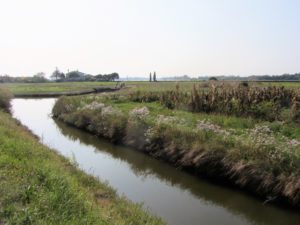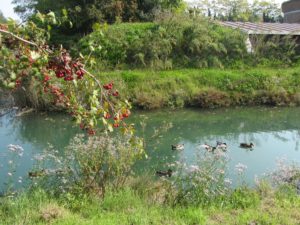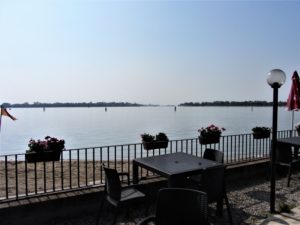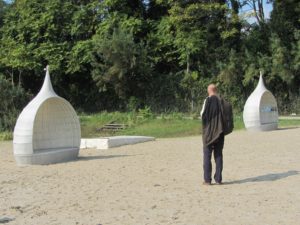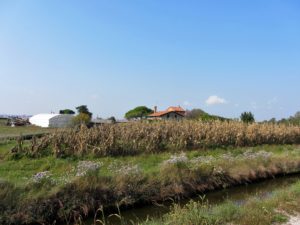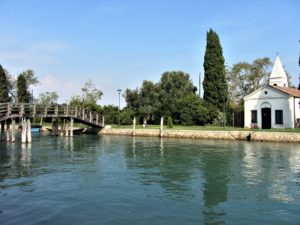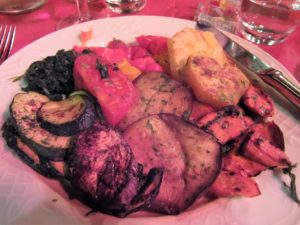SANT’ERASMO
Apparently Sant’Erasmo is the largest island in the Venetian lagoon; it is also largely free from tourists. It is known as the Garden of Venice and crops sold at the Rialto market in Venice are grown there – artichokes, asparagus, tomatoes, lettuce etc. Most of the people who live there work on the land. Sant’Erasmo is long and narrow and mainly covered in fields and small-holdings with polytunnels – it is also very quiet. The no. 13 vaporetto service leaves for Sant’Erasmo from Fondamenta Nove and takes about half an hour to reach the island, which is east of Venice and fairly close to Murano. In the summer there is also a service (no. 18) from The Lido, calling en route at Murano. The island is popular with Venetians as a place to go in their small boats, moor up and visit the seasonal cafe with its nearby beach, or perhaps hire a bike at the island’s only accommodation. Sant’Erasmo is flat and has quiet roads so as long as someone with a wheelchair could be got on and off a ferry it would be a good place to get round.
We eventually visited Sant’Erasmo in September 2017; it was somewhere my husband had wanted to see for a long time but we are usually in Venice in October or November and the weather is not always ideal for visiting such a rural island.
There are three vaporetto stations on Sant’Erasmo and we landed at Capannone, which is the first stop. Even though I’d read up about it in advance we didn’t have a decent map and not much idea where to go once we arrived – although we had checked the times for the return journey. We got off the boat and just walked down the nearest road, on the basis that we couldn’t really get lost, the worst that could happen is that we’d end up walking right round the island! It was wonderfully peaceful and the only other people we saw while on our walk was a couple riding bikes, whom we saw again later, having obviously cycled all the way round the island. I think they were Dutch or German – definitely not Italian. Being September a lot of the crops in the fields that we saw had finished but we didn’t see the whole island. Eventually we found what looked like a small hotel (it was Il Lato Azzurro – a bed and breakfast) and we went in the grounds hoping to find somewhere to eat but there was nobody about, although it was obviously the place that rents out cycles. We carried on and saw a group of school children with some teachers; they appeared to be having a lesson on ecology. A little further on we came across a round building, with ducks swimming in a moat; we later learned that this was the Torre Massimiliana: a fort had been built there during Napoleonic times but was later destroyed and replaced with another tower by Archduke Maximilian of Austria. It has been renovated fairly recently and is sometimes used for exhibitions, which is the only time it’s open to the public.
Close by we found a bar/trattoria (Bar dei Tedeschi) and sat down at a table, whereupon the owner excitedly rushed up and started laying it and handing out menus. We tried to explain that we only wanted snacks and drinks but he didn’t speak English and our Italian is not good, but we got our message across and he then pointed to tables in a different section of the terrace, to which we moved, feeling rather embarrassed. Inside was a self-service counter but the only things on display were a sort of cheese sandwich; as we could see no other choices we each had one of these and beer or wine. The sandwiches were ok, but I think that possibly they could have been toasted if we had asked – the owner certainly didn’t suggest it – but they `filled a hole` as my mother would have said. We followed this with icecreams from a serve-yourself cabinet and there were also cold drinks in a refrigerated cabinet, so all in all our lunch was ok. It was a lovely setting, and we sat looking out over the water at boats, either sailing past or being rowed Venetian style by someone standing up facing forward. Luckily the toilets inside were easy to find and we then walked out onto the adjacent small beach, which at that time of the year and during the week, was empty apart from 3 fancy woven seats. We wandered through the trees at the back of the beach and followed a path back to Via Forti.
At this point what we should have done was to continue walking round the island but I’d read about Le Vignole, the neighbouring island, and was desperate to have a look at it as it sounded interesting so we set off back to the vaporetto station and caught the next ferry.
LE VIGNOLE
We disembarked and walked along a canal lined with houseboats. The only person we saw was a man working on his boat. We could see that some of the island was agricultural, like Sant’Erasmo but it was also inaccessible. There was a small picturesque chapel by the canal and a bridge that linked two parts of the island so we crossed over the bridge and tried to walk along the fondamenta on the other side. We hadn’t gone far when we started to encounter signs with `privato` and other things in Italian, which seemed to say `keep out` and `no entry` on them and as every path seemed private we turned around and went back to catch the next ferry back to Venice. What a mistake I’d made – I wish we had stayed on Sant’Erasmo longer instead of wasting our time on an island which was so private and inaccessible. I read later that a large part of Le Vignole is a military zone, so that part is completely out of bounds.
I would never return to Le Vignole but hopefully can go back to Sant’Erasmo some time and complete our circuit of that island. The short ferry ride back to Venice gave us good views of Murano, its glass factory chimneys and the lighthouse. It was lovely to get back to our hotel for dinner, where I ordered my favourite first course of roasted vegetables, confident that at least some of the ingredients were probably grown on Sant’Erasmo.
